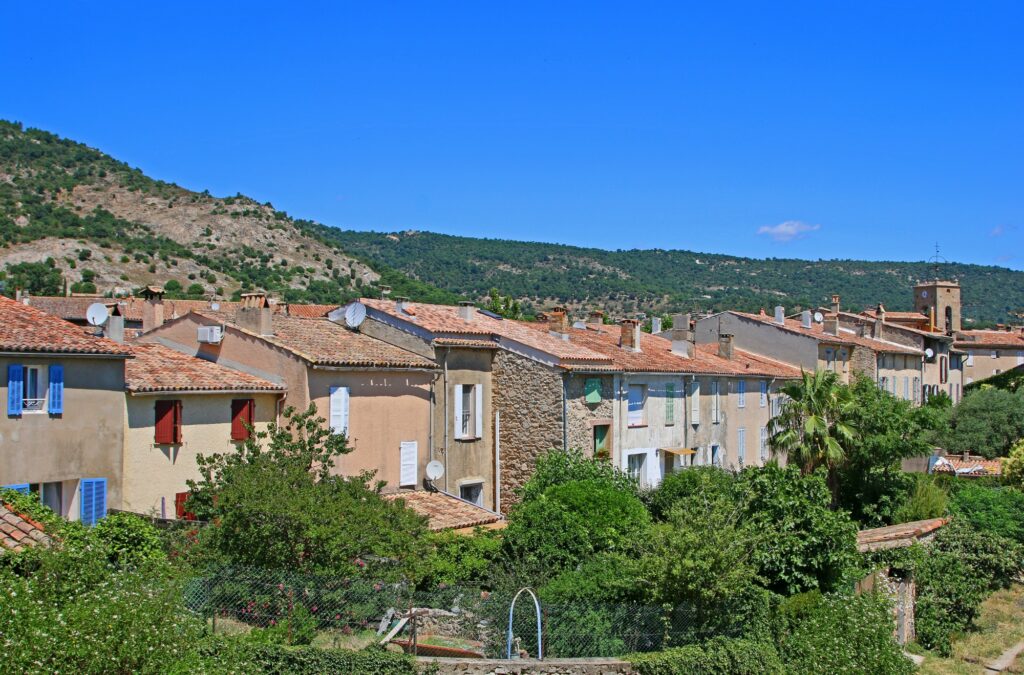
Le Plan de la Tour
A village in Provence
Deposited by a divine hand in an amphitheater of wooded, flower-filled hills, this singular village, surrounded by vineyards, blossoms in the heart of the Maures massif. But beware: one hamlet can hide many others…
“Benvengudo at Plan de la Tourre
From the Gulf, a narrow road winds through cork oaks, over small passes and plunges down to the plain and its vineyards, where the village takes root. Respectful of the richness of its terroir, this typically Provencal commune looks to the future with the determination to preserve an exceptional living environment in the heart of the Maures mountains, just a stone’s throw from the sea. At first glance, the village doesn’t seem very big, but it’s great to stroll through the narrow streets, discover the church bell tower, the fountains, the presbytery and the old-fashioned wells. Under the plane trees of Place Foch, the Provencal market comes alive on Thursdays, and shops are open every day, including Sundays. Soak up the local atmosphere on the Quatre Chemins bench…
25 hamlets, not one less!
Le Plan de la Tour is not to be visited, but discovered. This area is unique in the region: 25 discreet hamlets, scattered across the steep hills. Each has its own character and way of life, and it’s a joy to venture out in all seasons in search of these pearls of delightful toponymy: Les Brugassières, a place where heather grows, le Préconil, Vallaury, le Vernet, a place where alder grows, Prat Bourdin and its menhirs, le Revest… Stroll along the paths and discover the flora and fauna, following in the footsteps of a past that goes back to prehistoric times.
The great outdoors, a land of discovery
Want a glimpse? The “Gorgues” trail, accessible to all, offers a summary of the village: its vineyards, hamlets, two menhirs standing at the bend of a stream… To the north, the “sentier des mines” (mining trail) bears witness to the rich past of lead and silver mining. A natural climb from the plain to the surrounding hilltops. A pathway leads from La Garde-Freinet to San Peïre, via the Col de Vignon and the hills: at an altitude of 416 m, it’s easy to imagine this world apart: a true paradise for hiking, mountain biking, horseback riding or meditation… to each his own mode of transport!
Traditions are celebrated all year round
The rhythm of the seasons is punctuated by traditional festivals: in March, the Corso floats covered in white heather; at the end of April, plants and olive oil, the auto retro festival; in May Saint-Pons blesses animals and farm equipment for the donkey festival. Summer is brightened by night markets and balls, before the Festivel dans les Vignes shows. By September, the grapes have ripened, and it’s the turn of cooked wine to be honored. And then Christmas arrives, the hamlets are lit up, preparations are made for the lantern parade and the big wake gathers the inhabitants around the cacho fue. Le Plan de la Tour is a southern village, a fraternal village.
A little background
Plan de la Tour was created in 1792, from the detachment of part of Garde-Freinet. The main hamlet at the time was Saint-Martin. In 1835, it was extended by over a thousand hectares from the western part of Sainte-Maxime. Menhirs and dolmens have left their mark here since Neolithic times. In the Middle Ages, the seigneuries belonged successively to the viscounts of Marseille, the monks of Lérins and, in the 13th century, the Cistercians of the Thoronet abbey. Most of the hamlets that make up the area today correspond to the final phase in the reconquest of its territory by the monks of Le Thoronet in the 16th century.